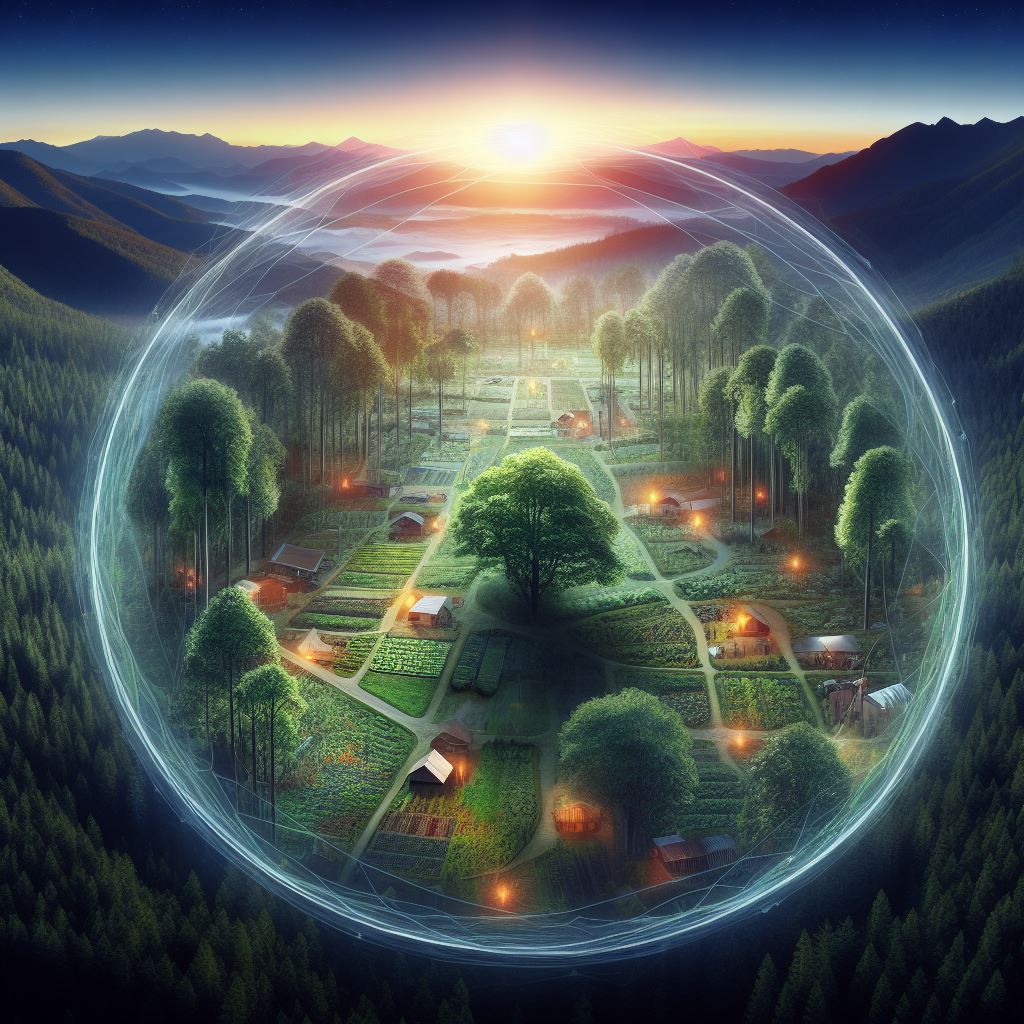Immerse yourself in the vibrant world of Forest Garden Integrations, a harmonious blend of nature and agriculture that takes sustainability to the next level. This blog post unravels the mysteries of forest garden integrations, offering insightful tips, practical information, and inspiring stories to help you cultivate your slice of paradise. As we delve into the heart of agroforestry, you’ll discover how integrating diverse plant species, from towering trees to humble ground covers, can create a resilient, productive, and eco-friendly garden.
So, whether you’re a seasoned gardener aiming to explore new horizons or a green-thumbed newbie eager to embark on a sustainable gardening journey, this enlightening post will guide you through the complexities and wonders of forest gardening. Let’s walk this green path together, nurturing our understanding of nature and sowing the seeds for a more sustainable future.
Understanding Forest Gardens
Forest garden integrations are a fascinating concept that combines the principles of ecology, permaculture, and sustainable practices. This multidisciplinary approach to gardening is far more than just planting trees and hoping for the best. It’s a strategic method of utilizing nature’s wisdom to create a resilient and productive ecosystem right in your backyard.
The essence of a forest garden lies in its design, which mimics a natural forest. In essence, it’s a planned forest filled with edible and useful plants. These gardens are layered, meaning they have various strata, like tall trees, low trees, shrubs, herbaceous plants, ground cover, climbers, and root crops, all integrated into one system.

Forest garden integrations aim to maximize the symbiotic relationships between these diverse plants, insects, and wildlife. It’s like conducting a nature’s orchestra, where each player has a specific role that contributes to the harmony of the ecosystem. The tall trees provide shade and habitat for birds, the shrubs bear fruits and berries, the herbaceous plants enrich the soil, and the climbers use the vertical space efficiently.
Unlike traditional gardening, which often relies heavily on human intervention, forest gardens are mostly self-maintaining. After the initial set-up, nature takes over. The forest garden integrations allow for natural pest control, soil fertility, and water management, reducing the need for artificial inputs.
In this era of climate change and environmental degradation, forest garden integrations offer a sustainable way to grow food, promote biodiversity, and restore ecosystems. They embody the principle of working with nature, not against it. It’s a testament to the fact that our survival and well-being are intrinsically linked to the health of our planet.
So, next time you step into a garden, try to see it not just as a collection of plants but as a bustling community of life, a small-scale forest, a testament to the beauty and resilience of nature.
Concept and History of Forest Gardens
“Delving into the verdant world of forest garden integrations, we explore a concept that marries ecological wisdom with agricultural innovation. This practice, steeped in indigenous knowledge, mimics natural woodland ecosystems to create sustainable food systems. From its ancient roots in tropical regions to its modern iterations in diverse climates, the history of forest gardening is as layered as the gardens themselves.
It’s a tale of synergy where trees, shrubs, and crops all play crucial roles, creating a harmonious blend of biodiversity. The story of forest gardens is indeed a testament to nature’s ingenious integrations.”

Benefits of Forest Gardens
“Embracing forest garden integrations offers a myriad of benefits that are as profound as they are practical. This sustainable gardening approach not only enhances biodiversity but also aids in soil restoration and carbon sequestration. It’s a haven for wildlife, a smorgasbord of organic produce, and a living classroom for eco-stewardship.
Forest gardens are not just a green thumb’s playground but a crucial step towards environmental balance. They are the epitome of synergy, where each element contributes to a thriving, self-sustaining ecosystem. So, let’s delve deeper into the wonders of forest garden integrations and explore the benefits they offer to us and our planet.
Key Components of Forest Gardens
Forest garden integrations are an ingenious blend of natural ecology and human ingenuity, forming a self-sustaining ecosystem that provides food, shelter, and other resources. A well-designed forest garden is a symphony of interlocking elements, each playing a crucial role in the overall harmony of the system. The first component is the canopy layer, comprised of tall fruit and nut trees.
These arboreal giants form the backbone of the forest garden, providing shade and creating a suitable microclimate for the understory plants. Next is the understory layer, which includes smaller fruit and nut trees, shrubs, and vines. These plants perform a dual role by contributing to the diversity of the ecosystem and producing additional food resources.
The ground layer is made up of herbs, vegetables, and other edible plants that thrive in the dappled sunlight of the forest floor. These plants not only provide sustenance but also contribute to soil fertility through their extensive root systems. Lastly, the soil itself is a key component of forest garden integrations.
This complex mixture of organic matter and minerals is home to countless microbes, insects, and other organisms that decompose organic matter and recycle nutrients, maintaining the garden’s fertility. In conclusion, forest garden integrations are not only a sustainable way of producing food but also a means of preserving biodiversity and fostering ecological resilience. By understanding and harnessing the intricate relationships between these components, we can create forest gardens that are not just productive but also truly sustainable.
Types of Plants in a Forest Garden
In a forest garden, several types of plants function as key integrations, each playing a unique role in maintaining the garden’s ecosystem. These include canopy trees, smaller fruit and nut trees, shrubs, herbs, ground cover plants, climbers, and root crops. This eclectic mix of flora not only ensures a dense, layered structure that mimics a natural forest but it also promotes biodiversity and yield variety.
The cleverly designed forest garden integration presents a witty alternative to traditional gardening, offering a sustainable solution that enhances soil fertility, promotes wildlife, and takes advantage of vertical space.
Forest Layering System
In the realm of sustainable agriculture, forest garden integrations serve as an ingenious solution. This ecosystem-inspired approach mimics the natural layering system found in forests, creating a dynamic, multi-tiered garden teeming with biodiversity. The forest layering system integrates trees, shrubs, and plants at various heights, fostering a symbiotic relationship among them.
This not only optimizes space but also enhances soil fertility, reduces pest and disease incidence, and promotes a healthier, more resilient garden. So, let the forest be your guide and embrace the wisdom of its intricate, harmonious layering system to cultivate a thriving, sustainable garden.
Integrating Forest Gardens
Integrating Forest Gardens: A Symphony of Sustainability In the grand orchestra of ecological design, forest garden integrations play the role of a symphony conductor, harmoniously blending various parts of an ecosystem into a melodious whole. The concept of forest gardening isn’t new. It’s an age-old practice, tracing its roots back to ancient civilizations.
However, in the modern context, it has evolved into a sophisticated strategy for sustainable living. Forest garden integrations involve creating multilayered, perennial polycultures of trees, shrubs, herbs, vines, and groundcovers. It is a marriage of agriculture and forestry that mimics a young natural woodland, a habitat that’s supremely efficient at packing lots of biomass into a small area.
By specifically selecting plants that offer direct benefits to humans – be it food, fiber, or medicinal products – we essentially create an ecosystem that’s both self-sustaining and human-sustaining. But the magic of forest garden integrations doesn’t stop at being a source of produce. It extends to enhancing biodiversity, sequestering carbon, and improving soil health.
Moreover, it offers a resilient system that can weather challenges such as climate change and pest infestations better than conventional farming practices. In essence, forest garden integrations are akin to conducting a symphony of sustainability. Each plant plays its part in the ecosystem, and the whole system thrives, producing a melody of benefits.
It’s a brilliant masterpiece of nature and human innovation, resonating with the tune of resilience, productivity, and sustainability.
Steps to Create a Forest Garden
Creating a forest garden involves a series of strategic steps, each contributing to the sustainable harmony of the final green haven. This process, known as forest garden integration, begins with selecting an ideal location that receives adequate sunlight and rain. The initial groundwork involves soil preparation and planting of tall trees to provide a canopy.
Subsequently, smaller plants, shrubs, and groundcovers are added methodically, ensuring diversity and balance. The final steps include regular maintenance and monitoring for potential issues. Remember, patience is key in this ecological endeavor, as true beauty takes time to flourish.
Maintaining Your Forest Garden
Maintaining your forest garden requires a harmonious blend of knowledge, patience, and constant care. A successful forest garden integration is all about creating a self-sustaining ecosystem that not only thrives on its own but also increases biodiversity and productivity. It involves strategically choosing plant species that complement each other, ensuring regular pruning to maintain balance and shape, and adopting organic pest management practices.
Remember, the ultimate goal is to create a thriving natural environment that needs minimal intervention, so let nature take its course while you provide the necessary guidance.
Case Studies of Successful Integrations
Unearthing the Magic of Forest Garden Integrations: A Case Study Exploration The realm of forest garden integrations is a fascinating landscape, a testament to the power of nature and human ingenuity working harmoniously together. This blog section delves into compelling case studies that represent the epitome of successful forest garden integrations. These living examples of sustainable agriculture not only yield a bounty of food but also create a balanced ecosystem.
One profound example is the “Incredible Edible Forest Garden,” nestled in the heart of England. This project has transformed an ordinary space into a veritable cornucopia of edible plants, intertwining various food-producing trees, shrubs, and herbs in a self-sustaining system. We will unpack how ingenious planning and meticulous execution have led to a thriving garden that benefits both humans and the environment.
Another case study takes us to the tropics of Thailand, where an innovative farmer has integrated native trees and exotic species into a rich, productive forest garden. This integration has resulted in a garden that not only feeds his family but also contributes to the local economy, all while preserving biodiversity. In these case studies, the focus is not merely on the aesthetic appeal or the food production aspect of forest garden integrations.
It’s about creating a sustainable model that enhances the overall health of the ecosystem, contributing to soil fertility, water conservation, and biodiversity, among other benefits. These success stories underscore the potential of forest garden integrations to transform barren or under-utilized spaces into thriving ecosystems, echoing a compelling testament to the power of nature when paired with human innovation and respect. They serve as a beacon of hope and inspiration for those seeking to create sustainable and productive landscapes, inviting us all to partake in the symphony of nature’s bounty.
Forest Garden in Urban Setting
Incorporating forest garden integrations into an urban environment is an innovative approach to sustainable living. This concept, often described as ‘urban edible landscaping’, applies the principles of a forest ecosystem to a city setting, resulting in a harmonious blend of nature and urban life. It’s not just about growing trees and plants; it’s about creating a self-sustaining, biodiverse habitat that provides food, fosters wildlife, and enhances our well-being.
With careful planning and design, your urban space can transform into a verdant oasis, proving that concrete jungles and forest gardens can co-exist beautifully.
Forest Garden in Rural Setting
In the realm of sustainable agriculture, forest garden integrations in rural settings are swiftly gaining popularity. These lush, green oases are more than just aesthetically pleasing. They are dynamic ecosystems that leverage the principles of permaculture to produce food, fuel, fiber, and fodder.
By mimicking the structure and function of natural forests, forest gardens open up a world of possibilities for rural communities, providing not just sustenance but also opportunities for income generation and biodiversity conservation. So, step into the world of forest gardens and discover the potential for a greener, more sustainable future.
Frequently Asked Questions
What are the essential elements for forest garden integrations?
The essential elements for forest garden integrations include a diverse selection of edible and beneficial plants, a well-thought-out design that mimics natural forest patterns, efficient water and nutrient cycling systems, and a strong emphasis on perennial and self-seeding crops.
What is the role of permaculture in forest garden integrations?
Permaculture plays a crucial role in forest garden integrations by providing a set of design principles that mimic the patterns observed in nature. These principles guide the creation of sustainable and self-sufficient agricultural systems, like a forest garden.
How can forest garden integrations improve food security?
Forest garden integrations can improve food security by providing a diverse range of food crops all year round. Its emphasis on perennial and self-seeding crops also means less dependency on external inputs like seeds and fertilizers.
What challenges might one face while implementing forest garden integrations?
Some challenges in implementing forest garden integrations may include initial setup and maintenance costs, the need for specialized knowledge and skills, the time it takes for the system to become fully productive, and potential pests and diseases.
How do forest garden integrations benefit the environment?
Forest garden integrations can significantly benefit the environment by reducing soil erosion, increasing biodiversity, creating wildlife habitats, and sequestering carbon. It also uses less water and energy than conventional farming methods.
Conclusion
Forest garden integrations are all about harmoniously merging the age-old wisdom of the forest with the innovative practices of gardening. It’s not just about planting trees and growing vegetables but rather creating a self-sustaining ecosystem that benefits both man and nature. It’s like hosting a symphony in your backyard, where every plant, insect, and bird has a role to play in the orchestra of life.So, next time you think about gardening, remember – you’re not just a gardener; you’re the conductor of a green symphony. Embrace the forest, nurture the garden, and watch nature play its masterpiece.
